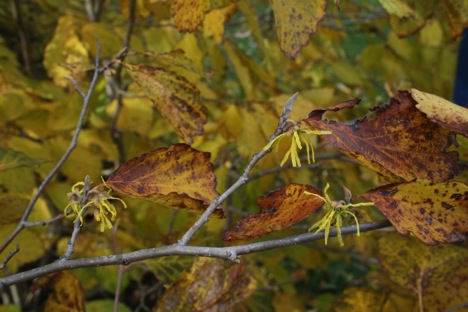Many thanks to Luther College Associate Professor Beth Lynch for adapting and sharing an article and photographs she first published in November 2013. I had no idea witch hazel was native to Iowa. Steve Peterson alerted me to Beth’s work and shared some of his own pictures of witch hazel blooming in Winneshiek County. I enclosed those at the end of this post. -promoted by desmoinesdem
TINY JOYS OF A BOTANIST
I write to share with you one of my tiny joys of late fall. I took this photograph during the first week of November. What is it? A twig with some leaves, right? Look again. What are those yellow stringy things hanging from the twig? Spiders? Whiskers? Look closely.
These are the bright yellow petals of the witch hazel flowers. Think about it: flowers blooming in November! Every fall when most of the leaves have dropped from the trees and the sun is weak, I look for these cheery little flowers on the witch hazels. They bring a bit of warmth to the cold dark days when I seem to need it most. Tiny joy, indeed.
Witch hazel (Hamamelis virginiana) is a tall shrub that grows in the oak and maple forests of northeastern Iowa. It is easily killed by fires and logging so it grows only in few protected locations. The shrubs blend into the background for most of the year, but in the late fall they offer a bit of sunshine to those who take the time to notice. Soon the leaves will be gone and it will be even easier to see the bright flowers among the gray branches.
Once you have found these shrubs with their odd little flowers full of pollen and nectar, perhaps you will wonder, as I do, why they wait until late fall to bloom. Most plants growing in the shady, dark hardwood forests flower in the early spring when there is lots of sunlight and pollinators are easy to lure to the flowers. Other species flower later into the summer when the canopy has filled in. But, none, aside from the witch hazel, waits to bloom until temperatures have dipped below freezing and winter winds come creeping around. Why do they do this?
Ha! I’ve tricked you into playing science with me. Biologists notice patterns: plants flower in the spring and summer, not in the winter. Then we make up explanations and hypotheses for these patterns. Plants bear their showy flowers in the spring and summer because that is when they are likely to be pollinated by insects that will transfer pollen between plants (allowing for sexual reproduction) in exchange for a nectar reward. The exceptions to the patterns, like the fall-blooming witch hazel, force us to re-examine our explanations.
Botanists who have studied the reproductive biology of witch hazel have learned that to produce seeds, the flowers must be visited by pollinators, including flies and small bees, but mostly fungus gnats (Anderson & Hill 2002). Only a small percentage of the flowers receive enough pollen to produce seeds.
A potential clue to its out-of-sync flowering schedule may come from the forests farther east where there are two species of Hamamelis. One of them, Hamamelis vernalis, flowers in the early spring (as its Latin name suggests). It has been suggested that “our” witch hazel, Hamamelis virginiana, has evolved to flower in the fall to avoid competing for pollinators with its close relative (Shoemaker 1905). By flowering in the late fall when nothing else is blooming, it receives the exclusive services of whatever fungus gnats happen to be in the neighborhood.
If you haven’t yet had enough witch hazel joy, take one more look at the plant. In addition to flowers, you should be able to find ripe fruits from last year’s flowers. (That’s right, it will take one full year for the flowers that you see now to produce mature fruits.) The fruits are little brown capsules (smaller than an acorn) that split open to reveal shiny black seeds inside. The smooth, vaguely banana-shaped seeds are slowly squeezed out of the fruit as it dries, landing up to 20 feet from the parent. The lucky ones will escape predation, remain dormant through two long cold winters, and finally germinate and grow into new witch hazel plants bearing tiny joy for all who take the time to look.
References cited:
Anderson, G. J., & Hill, J. D. (2002). Many to flower, few to fruit: the reproductive biology of Hamamelis virginiana (Hamamelidaceae). American Journal of Botany, 89(1), 67-78. doi: 10.3732/ajb.89.1.67
Shoemaker, D. N. (1905). On the Development of Hamamelis virginiana. Botanical Gazette, 39(4), 248-266. doi: 10.2307/2466415
About the author: Beth Lynch teaches courses in ecology and botany at Luther College and lives with her spouse and two dogs on what used to be a small working farm next to Seed Savers Exchange. She takes great delight in finding rare plants tucked away in the hills and valleys around her and is dedicated to protecting and restoring habitats for native species.
Note from desmoinesdem: Steve Peterson gave me permission to share some of his photographs of witch hazel. He took these pictures last week in Canoe Township, Winneshiek County. Spiny witch hazel galls are visible in the second picture.








1 Comment
Thank you!
I learned so much about witch hazel from this post, and really appreciate it.
PrairieFan Thu 26 Oct 1:13 AM